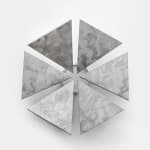
George Rickey United States, 1907-2002
116.8 x 127 x 33 cm
Further images
These mobiles strategically distributed weight to ensure meticulous movement according to Rickey's design. A single lever or a combination of pieces attached to both ends of a wire creates a delicate equilibrium—a weight on one side, a counterweight on the other. He also experimented with balance and motion principles applied to elements standing upright on posts. Introducing knife-edge bearings and gimbals, Rickey unlocked a new realm of possibilities wherein sculptures could now stand in a vertical or horizontal position, moving within a specific plane. Rickey's line sculptures embody a harmonious blend of unpredictability introduced by the breeze and predetermined control achieved through meticulous engineering and craftsmanship. The precision in the construction ensures that each line moves exactly as intended by the artist, creating an exquisite choreography of form and motion.
--
George Rickey (b. 1907 in South Bend, IN – d. 2002 in St. Paul, MN) dedicated over five decades to the creation of what he termed "useless machines," poetic sculptures that interact with their environment. Designed for public spaces, these works reshape the landscape and draw attention to the nuances of light, movement, and composition. Among the natural forces, it was the movement of the wind that most captivated Rickey. He articulated this fascination by stating, “The artist finds waiting for him, as subject, not the trees, not the flowers, not the landscape, but the waving of branches and the trembling of stems, the piling up or scudding of clouds, the rising and setting and waxing and waning of heavenly bodies.”
Rickey initially studied painting in Paris before returning to the U.S. in 1930, where he built a career as a painter and muralist during the 1930s and early '40s, completing works through the WPA and other public commissions. His artistic journey took a significant turn during his service in the Army Air Corps, where he rediscovered a long-dormant aptitude for mechanics. Although he had been inspired by Calder’s mobiles in the mid-’30s, it was during the War that his vision for a new form of art began to take shape. Working with gyroscopes on B-29 gunnery sights, he revisited childhood memories—such as the knife-edge gimbal that kept his family’s yacht level in Scotland and the pendulum mechanics from his grandfather’s clock-making shop. During his free time in the workshop, he began experimenting with mobiles and small "machines," later creating sculptures inspired by the movement of flowers, sedges, and celestial bodies.
Soon after, Rickey devoted himself to exploring motion in sculpture, producing dynamic works that utilize simple geometric forms like lines, squares, and circles. His profound understanding of engineering and mechanics is evident in his sculptures, which engage with the wind while maintaining a balance among their elements. The arrangement allows for a consistent relationship between parts, but the movement remains unpredictable, creating a dance that is always changing. This tension is a defining characteristic of Rickey’s work, as he believed in creating art that requires patience and observation. “I think it’s important to make art that you have to wait for,” he stated, highlighting how his sculptures oscillate gracefully through an infinite number of compositions, engaging with the natural world—wind, light, rain, and more.
Much of Rickey’s work was created in his studio in East Chatham, New York, where he settled in 1960. Before that, he lived and taught in various cities, including Bloomington, IN; New Orleans, LA; and New York, NY, and he spent significant time in Scotland and Britain during his youth. In addition to his studio in East Chatham, he had studios in Berlin, Germany, and Santa Barbara, CA. Rickey's art is in the permanent collections of over 150 museums worldwide, including the Hirshhorn Museum and Sculpture Garden, the Los Angeles County Museum of Art, the Museum of Modern Art, and the Metropolitan Museum of Art.
Provenance
George Rickey EstateExhibitions
Chicago, Fairweather Hardin Gallery, George Rickey Sculpture, October 10 – November 4, 1978New York, Solomon R. Guggenheim Museum, George Rickey: Retrospective, September 7 – October 4, 1979
Philadelphia, Makler Gallery, George Rickey at the Makler Gallery, November 8 – December 3, 1980
Houston, TX, River Oaks Garden Club/John Parkerson, George Rickey, May 12 – 25, 1985
New York, Maxwell Davidson Gallery, George Rickey, October 7 – November 15, 1986
Kruishoutem, Belgium, Stichting Veranneman, George Rickey: Indoor/Outdoor Sculptures, May 7 – June 18, 1988
Sherman Oaks, CA, Carl Schlosberg Fine Arts, George Rickey: In Celebration of His 85th Year, April 5 – May 8, 1992
Denver, CO, Inkfish Gallery, George Rickey Recent Sculptures, May 7 – 29, 1993
New York, Maxwell Davidson Gallery, George Rickey in Recognition of his 90th Year: Recent Sculptures, November 18 – December 20, 1997
Osaka, Japan, Gallery Kasahara, George Rickey, April 3 – 28, 2000
New York, Cooper Union, Art & Mathematics 2000, November 7 – December 15, 2000
Pittsfield, MA, Koussevitzky Art Center, Berkshire Community College, Art & Mathematics 2001, February 1 – March 30, 2001 New York, Kasmin, George Rickey: Wall Reliefs, January 11 – February 17, 2024.
Literature
George Rickey at the Makler Gallery, exh. cat., Philadelphia, Makler Gallery, 1980, no. 1.George Rickey: In Celebration of His 85th Year, exh. cat., Sherman Oaks, CA, Carl Schlosberg Fine Arts, 1992, n.p.George Rickey in Recognition of his 90th Year: Recent Sculptures, exh. cat., New York, Maxwell Davidson Gallery, 1997, n.p. George Rickey, exh. cat., Osaka, Gallery Kasahara, 2000, p. 6 and front cover.
